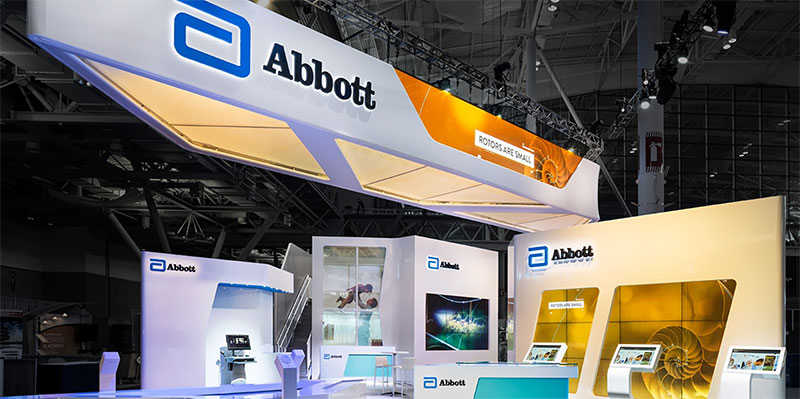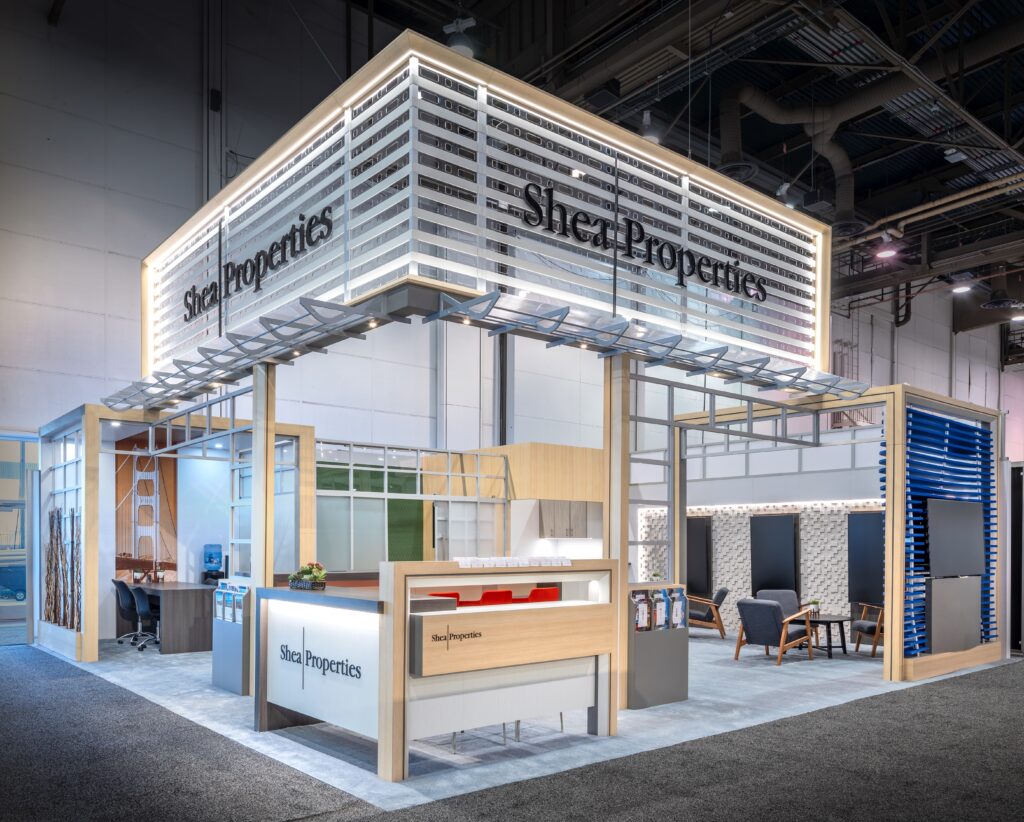Events are a powerful tool for driving leads, increasing brand awareness, and one of the few opportunities to connect with your audience in person.
It’s also important to note that without proper planning and a clear picture of your business objectives, trade shows can also be a waste. A waste of time—and perhaps, more importantly, a big waste of money.
So, knowing the stakes are high, how do you know if you’re getting a good return on investment on your trade show dollars?
Well, the answer depends on several things—but, it all comes back to what you’re hoping to gain from this experience.
Boost Trade Show ROI by First Defining Success
To calculate event ROI, subtract the total cost of your event from the total revenue generated and divide that amount by the total cost of the event.
The equation should look like this:
[(Total Sales Revenue – Total Cost of the Event) ÷ Total Cost of Event] X 100 = ROI
That said, where things like tickets sold or sales generated are clearly linked to money in the bank, other KPIs are way more subjective. So, if your goal is creating a memorable brand experience, success might present differently.
A few things to think about going into the process:
- What do you hope to get out of the event?
- Do you hope to collect feedback from customers?
- Are you aiming to get a certain number of new accounts?
- Do you have a sales goal?
- What are the best and worst possible outcomes associated with this experience?
Here are some examples of goals you might have, as well as how you can measure success:
Whether you’re thinking about impressing the media or the general public, you’ll want to present your company as an innovator in your space. What are you doing that no other companies are doing right now? Is there a product launch happening at the show? An exciting brand activation?
How can you present that “uniqueness” to media outlets, customers, and industry insiders?
Partner Up to Expand Your Reach
Of course, one of the bigger challenges we see with exhibitors is spreading the word far and wide.
One tactic that can help you get more mileage out of your trade show appearance is pairing up with another company in your industry with the same (or similar) target audience. Not a competitor—rather a product or service that complements what your company offers.
Ideally, you’ll want to target potential partners with more experience, a larger customer base, or access to a market you haven’t yet broken into.
A few things you could propose to a potential partner:
- Share leads and contact lists
- Creating joint content—think podcasts, speaker sessions, pre-event webinars.
- Asking for help and advice regarding your expo
- Work together on social media content
Of course, this arrangement needs to be mutually beneficial. As you make a list of potential partners, think about how you can make your ask in a way that highlights what’s in it for them.
How will you promote their company/your joint efforts? Can you offer them some numbers in terms of traffic/social media followers/engagement?
Another idea is hosting mini-sessions with partners. This could be something that looks more formal–a series of short lectures or a panel discussion. Or, you could adopt a more interactive approach–co-hosting a roundtable discussion with show attendees.
Take to Social to Amplify Your Message
As you promote your event, your goal is to get in front of as many (relevant) eyeballs as you can. Be sure to let people know what they’ll learn, experience, and who they can expect to meet if they show up.
Make it a Team Effort
Work with your marketing team to develop a strategy for sharing social media responsibilities. Who is responsible for paid ads? For building a user-generated content campaign? For getting employees on board? Writing and promoting related content?
All of these elements should work together, across all touch points, but you’ll get the most ROI from approaching this process as a team.
Tools like Buffer or TweetDeck make it easy to post from multiple accounts at a time, as well as fill up your calendar so you’re always promoting your latest blog posts, announcements, and event updates.
Engage Like Crazy
During the lead up, it’s a good time for you to focus on brand awareness campaigns and building bridges between your audience, influencers, and any speakers, sponsors, or partners you’re working with.
And honestly, much of the work you’ll be doing here is sharing and following. One of the easiest ways to kick start your engagement strategy is to get on Twitter and retweet influencers, experts, and people involved in your industry.
While other channels like LinkedIn, Facebook and Instagram are definitely worth your time, leveraging the conference hashtag and reaching out on Twitter’s fast-moving platform offers big impact with minimal effort.
Look toward channels like Facebook and LinkedIn Groups as a way to build up your community in advance. Based on this chart of LinkedIn’s top industries, chances are there’s a group for you.
Of course, you should promote your own content too–like teaser videos, speaker announcements, updates, blog posts, and so on–but it’s better to think about how you can join new conversations and participate in ongoing discussions.
Schedule Meetings with Key Accounts
Before the show, you’ll want to reach out to industry experts, vendors, or anyone else you’d like to connect with on the big day.
Be sure to introduce yourself—and ask if you can schedule a few minutes of their time during the show. In some cases, exhibitors will receive a list of attendees—as well as access to a portal where they can book short meetings. Check in with your on-site coordinator if you’re not sure about this.
If the show doesn’t provide a list of participants or a networking portal, don’t sweat it. Just be sure to reach out on LinkedIn, via email, Twitter, or wherever else industry contacts hang out online.
Before you start sending out cold emails, do a little digging. Check LinkedIn to see if you have mutual contacts who can make an introduction. And, of course, do your best to identify a few details so you can personalize the outreach process.
And finally, once you’ve locked in some appointments for the big day, be sure to send out some basic info about your brand–be it an introduction video, a guide to features and benefits, or an outline of what you hope to get out of this interaction. This allows you to cut to the chase when you do meet in person, as trade show meetings can be pretty short.
Bring Games and Interactive Demos into the Mix
We’ve said it before, but this tip is worth repeating—bringing an interactive experience into your booth is one of the best ways you can make sure that people remember your brand.
Remember, games and activations shouldn’t be too long or too complicated. Keep things simple enough so you’re not forcing any extra work on attendees.
A few ideas that tend to work well:
- Scavenger hunts
- Interactive demos
- Giveaways and contests
- Team building exercises
It’s also worth pointing out that interactive activities don’t have to be games in a traditional sense. Here, we have an example of a booth we designed for Accenture’s Dream Force exhibition. Their booth was loaded with touchscreen displays that let visitors review insights at their own pace.
Whether you opt for a VR demonstration of your latest product or host a contest in your booth, be sure to collect contact details as the price of entry. Click To TweetYour attendees know the drill, and won’t mind handing over an email address as long as they can see some value in the experience.
This will allow you to see which attendees were interacting with your content – and later, whether your approach paid off.
As far as measuring success goes, here are a few things to keep an eye on:
- During the event and in your follow-up activity, look at social media activity–is there an influx in mentions? Followers?
- How is your event hashtag performing? How does that track with performance during your pre-event marketing strategy?
- How many leads came from this game/activity? How does that compare to last year’s lead gen numbers?
- How many sales did you make?
As you collect contact information, make sure that you store details in an app that can then be sent to your marketing team/sales reps for further communication. Add these folks to your prospect list and reach out on LinkedIn.
The thing is, in-person interactions don’t come with the digital trail you’ll find with your social media communications or your email marketing campaign–instead, you’re relying on your memory to create essential data points.
For More Ways to Boost Trade Show ROI, Contact Echelon Design
Trade shows are a great opportunity to make contact with people that can help you advance your business, whether they’re new customers, clients, and partners, or industry influencers and the media.
That said, if you fail to follow up after the show, all of that hard work, time, and money is as good as gone. Often, exhibitors collect business cards and emails, only to forget all about them once they head home.
At Echelon, we take care of everything from event strategy to booth design and brand activations. While it’s up to you to nurture new relationships, we’ll help you find creative, captivating ways to tell your brand story and get it in front of the right audience.
Get in touch and let’s start planning your next big event.







